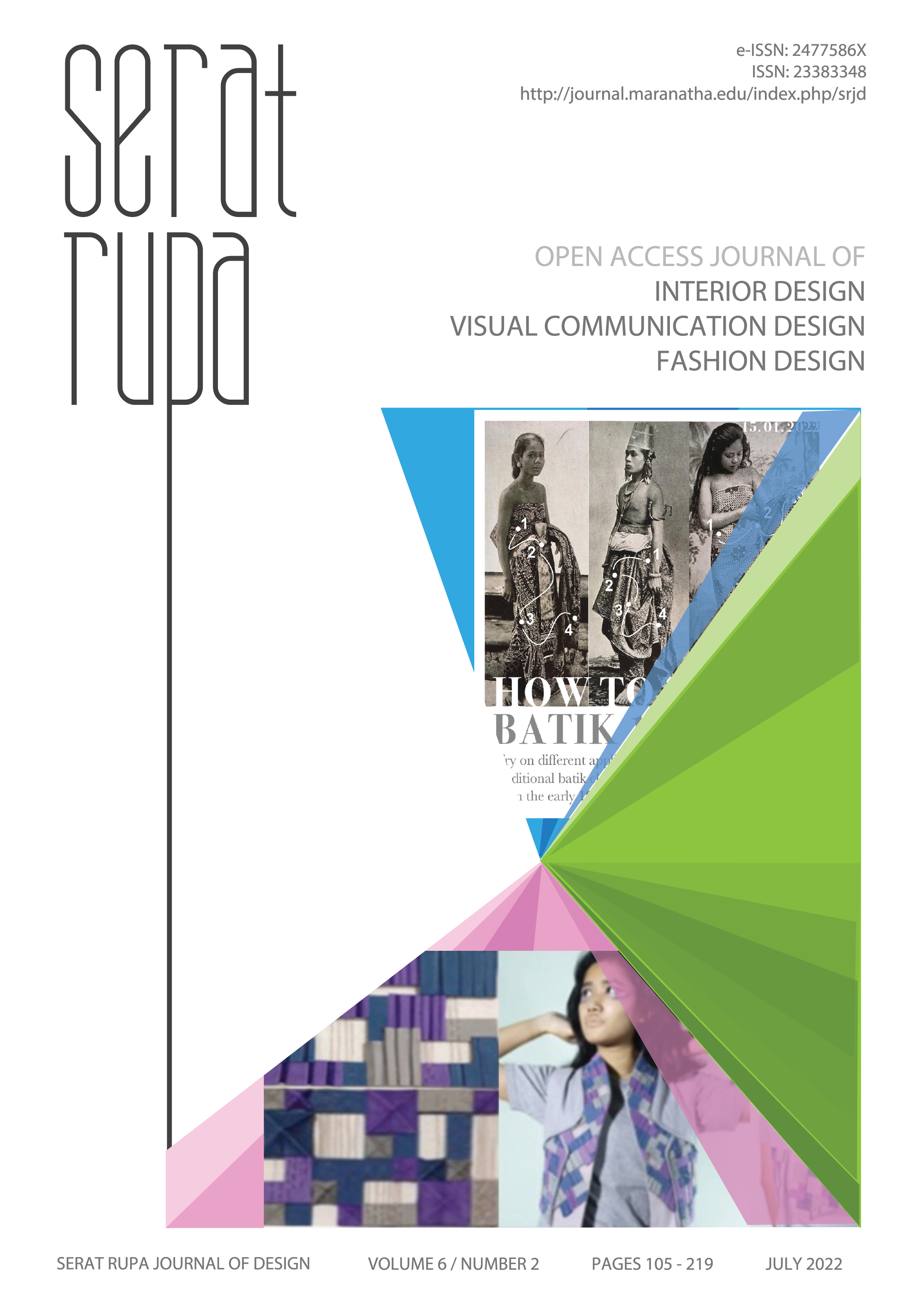KAJIAN MATERIAL DRIVEN DESIGN DALAM DESAIN AKSESORIS FASHION BERBASIS EKSPLORASI MATERIAL SWAKRIYA
Isi Artikel Utama
Abstrak
Unduhan
Rincian Artikel

Artikel ini berlisensiCreative Commons Attribution-ShareAlike 4.0 International License.
Referensi
Adam, H., & Galinsky, A. D. (2012). Enclothed cognition. Journal of Experimental Social Psychology, 48(4), 918–925. https://doi.org/10.1016/j.jesp.2012.02.008
Ashby, M. F. (1999). Materials selection in mechanical design (2nd ed). Butterworth-Heinemann.
Ashby, M., & Johnson, K. (2003). The art of materials selection. Materials Today, 6(12), 24–35. https://doi.org/10.1016/S1369-7021(03)01223-9
Aspers, P., & Godart, F. (2013). Sociology of Fashion: Order and Change. Annual Review of Sociology, 39(1), 171–192. https://doi.org/10.1146/annurev-soc-071811-145526
Banister, Emma & Hogg, Margaret & Decrop, Alain & Roux, Dominique. (1 Juni 2005). Symbolic Consumption: The Interplay Between Distinction, Distastes and Degrees of Rejection. Makalah dalam European Advances in Consumer Research Volume 7 Conference, Goteberg, Swedia
Barati, B., & Karana, E. (2019). Affordances as Materials Potential: 13(3), 19. Diunduh 6 November 2020 dari http://www.ijdesign.org/index.php/IJDesign/article/view/3419/879
Chun, N. (2021). Fashion Design Rediscovered: A Theory on Dressmaking Practice. The Design Journal, 24(1), 97–114. https://doi.org/10.1080/14606925.2020.1851426
Costa, Moema & Providência, Bernardo & Cunha, Joana. (4 September 2013). Approach to emotional design of fashion accessories. Makalah dalam 3rd International Conference of Design, Engineering & Management for Innovation, Porto, Portugal.
Crippa, Gaia., Rognoli, Valentina., & Levi, Marinella. (September 2012). A STUDY ON THE RELATIONS BETWEEN MATERIALS AND EMOTIONS IN INDUSTRIAL PRODUCTS. 10. Makalah dipublikasikan dalam Proceedings 8th International Design and Emotion Conference London 2012, London, Inggris.
Göklüberk Özlü, P., & Dengi?N Sevi?Ni?R, S. (2019). AESTHETICAL AND EMOTIONAL EFFECTS OF MATERIAL ON CLOTHING DESIGN. The Turkish Online Journal of Design Art and Communication, 9(1), 42–51. https://doi.org/10.7456/10901100/006
Karana, Elvin. (2009). Meanings of materials.Tesis Master of Industrial Design Middle East Technical University, Ankara, Turki.
Karana, E., Pedgley, O., & Rognoli, V. (2014). Introduction to Materials Experience. Dalam Materials Experience. Elsevier. https://doi.org/10.1016/B978-0-08-099359-1.02001-4
Karana, E., Barati, B., & Rognoli, V. (2015). Material Driven Design (MDD): A Method to Design for Material Experiences. International Journal of Design 9 (2). Diunduh 16 November 2019 dari http://www.ijdesign.org/index.php/IJDesign/article/view/1965/693
Kawamura, Y. (2005). Fashion-ology: An introduction to fashion studies. Berg.
Sörensen, C. A., Jagtap, S., & Warell, A. (8 September 2016). Material Selection In Industrial Design Education – A Literature Review. Makalah dalam International Conference on Engineering and Product Design Education, Aalborg University, Denmark.
Sörensen, Charlotte A. (2018). A Material Framework for Product Design - The development of reflective material practices. Disertasi Department of Design Sciences Lund University, Lund, Swedia.
Steffen, D. (2009). Categorizing product meaning: an investigation into the product language of clothing and fashion. In The 5th International Workshop on Design & Semantic Form & Movement, Taipei, Taiwan. Diunduh 16 November 2021 dari https://blog.hslu.ch/product/files/2009/11/productmeaning.pdf
Thornquist, C. (2018). The Fashion Condition: Rethinking Fashion from Its Everyday Practices. Fashion Practice, 10(3), 289–310. https://doi.org/10.1080/17569370.2018.1507147
Vinken, B. (2005). Fashion zeitgeist: Trends and cycles in the fashion system (English ed). Berg.
Wahyuningtyas, D. P., Ruhmana Sari, S. U., & Hasanah, S. M. (2020). Pelatihan
Swakriya Dengan Pemanfaatan Barang Bekas Menjadi Benda Fungsional Sebagai Upaya Kemandirian Ekonomi. Amal Ilmiah : Jurnal Pengabdian Kepada Masyarakat, 1(2), 148. https://doi.org/10.36709/amalilmiah.v1i2.8831

